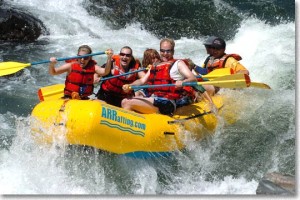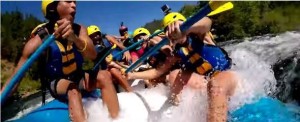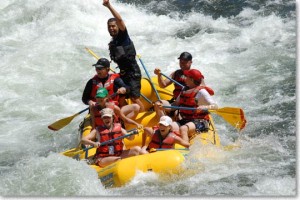When I wrote my first family travel guide to California for Fodor’s 20 years ago, I took my children — Grael, then age 14, and Lia, then age 11 — all over the state as a vital part of the research.
Usually I could sense right off the bat which attractions and activities they liked: going on rides at Universal Studios theme park, good; driving endlessly around Lake Tahoe checking out hotel rooms, bad. Camping in Death Valley, good; walking tour of Monterey Bay Historic Park, bad. (Lia was particularly bored with that one.)
One activity I knew didn’t bore her, though, was our whitewater rafting trip on the American River in the California Gold Country, with an outfitter called Adventure Connection. What I didn’t know for sure at the time was whether she found it exhilarating or terrifying.
Several years later, in high school, she wrote the following essay, which brought home to me just how vital a travel adventure can prove to be in a child’s life. I came across it the other day while sifting through some old boxes, and am reprinting it now in hopes that if you ever wonder whether or not your children or grandchildren remember or benefit from your travel experiences together, wonder no more.
While the particular experiences they remember and cherish will no doubt vary by the child, travel can provide some of the most formative and educational — in the broadest sense of the term — moments in their lives.
Here’s Lia on the subject of whitewater rafting and a scary-sounding class III++ rapids called Troublemaker.
Troublemaker: A Whitewater Memoir
By Lia Norton
It was the Summer of Moxie. I left elementary school brimming with confidence and satisfaction. Ready to try anything, I enthusiastically joined my father and 14-year-old brother on a car trip up to the California Gold Country.
Our destination: the South Fork of the American River for some good old-fashioned whitewater rafting. Being 11 years old, I won’t claim I wasn’t slightly nervous. The only other rafting I’d done (in Wyoming) consisted of floating down the farthest thing from rapids I could imagine, the most boring river experience of my life. Now, without my mother there to step in and assume the role of the family chicken, it was up to me to be apprehensive.
Arriving at the designated campsite, I was relieved to notice the presence of quite a few children; even better, children younger than I was. And the next morning, when my family was placed in a raft with a married couple whose brood consisted of a girl my age and her younger brother, I began to relax considerably.
Our raft was also blessed with the leadership of the most beloved guide on the trip, Lumpy. Jovial and easy-going, Lumpy invited me to take the seat beside him in the rear of the raft. I couldn’t have been more excited to start our voyage down the river.
A Rafting Primer
Now before I go further, I’ll take a moment to explain the caste system of the river to those who are unfamiliar with rafting. There are five levels of navigable rapids, one being the lowest and five being the highest; these are often inter-categorized by + signs, signifying more difficulty within that level.
Class I is the floating I mentioned previously. This trip would consist mainly of class II and III rapids, meaning plenty of excitement but not enough imminent danger to require the use of helmets (normally reserved for classes IV and V), at least back then. I’d heard my dad mention the presence of a Class III++ rapid at the trip’s closing, but I figured that as long as it stayed within the Class III category, it wasn’t anything to worry much about.
The Voyage Begins
The first day down the river we hit a number of Class II, II+ and III rapids, with such names as Meatgrinder and Nurse’s Office. Though they sounded menacing, those waves of whitewater carried me through the most exhilarating feelings I had ever experienced, and left me with a sense of accomplishment that no award or honor could come close to duplicating. (On a rafting trip, everyone has to paddle as hard as they can, following the guide’s instructions — “Paddle left! Paddle right!” — in order to go with the flow of the churning water. It’s a team effort and everyone must contribute for the raft to successfully conquer the rapids.)
That night after dinner everyone was called to an important meeting. We sat around the campfire as the guides prepared a short slide show. After viewing several slides depicting other rapids, the presentation paused on the image of a rapid known as Troublemaker.
It was unlike anything we’d seen during the trip. The obstacle was made up of two distinct components: To the left side ran a literal waterfall; to the right, a huge, swirling hydrologic pit.
“Take a long look at this,” I heard a guide say. “We’ll be riding it tomorrow.”
Those were the only words I heard for the rest of the night. I refused to believe that this was the III++ I’d previously thought little of. There was no way they were the same. Eventually, I decided to keep an open mind. I convinced myself that the picture looked a thousand times worse than it would look in actuality.
But in the back of my mind remained one thought: Its name is Troublemaker.
Tomorrow Dawns
The next day, our convoy of rafts continued on its course with little trouble, the Class IIs and even IIIs now old news to our oh-so-experienced selves. Eventually, we reached a calm patch of water where we anchored the raft for a moment while Lumpy spoke. Throughout the trip, Lumpy had never shed his breezy exterior, keeping us upbeat during even the trickiest maneuvers. Only then did I realize the enormity of what lay ahead; Lumpy was no longer smiling.
Entirely too serious, he explained the necessary strategy for successfully surmounting Troublemaker, which lay just beyond the neighboring trees. Knowing now to keep as far to the left of the rapid as possible, we headed down the last stretch of calm water, the final raft of the group to face the watery demon.
Tomorrow: The Moment of Troublemaker Truth Arrives















Leave a Reply